If you are experiencing pain in your IT band, you’re not alone. This common injury can be quite frustrating to deal with. However, there are a number of stretches and exercises that can help provide relief. In this blog post, we will discuss the 10 best stretches and exercises for IT band pain relief. We’ll also provide instructions on how to perform each one. So if you’re struggling with IT band pain, make sure to give these exercises a try!
What Is An IT Band?
The iliotibial band (IT band) is a substantial fascial band that spans from the exterior of your hip to the exterior of your knee and shinbone.
Overuse and repetitive motions can cause IT band syndrome, also known as ITB syndrome, which can hurt, irritate, and inflame the tendons around your knee. Symptoms of IT band syndrome include pain on the outside of your knee, swelling or fluid around your knee joint, and difficulty using your leg or knee.
ITB syndrome, usually known as runner’s knee, also affects bodybuilders, hikers, and cyclists frequently.
Stretches and exercises that increase flexibility and strengthen the muscles that surround your IT band can aid in the recovery of ITB syndrome. There are a number of stretches and exercises you can perform to help relieve IT band pain and prevent further injury. These include exercises that stretch the hip flexors, hamstrings, and quadriceps.
Best IT Band Stretches And Exercises
Iliotibial band stretches and exercises are some of the most effective methods for treating IT band pain. These stretches and exercises can be done anywhere, at any time, to help alleviate the symptoms associated with ITB syndrome. Not only do these stretches and exercises improve flexibility in this large muscle group, but they also reduce tension along the band.
Try performing these stretches and exercises for at least 10 minutes each day.
Side Lying Leg Raises
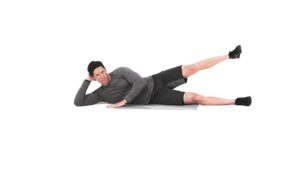 This exercise strengthens your glutes, hip abductors, and core, which helps with stability. Bend your bottom leg to provide greater support. Put a resistance band around your ankles to make it harder.
This exercise strengthens your glutes, hip abductors, and core, which helps with stability. Bend your bottom leg to provide greater support. Put a resistance band around your ankles to make it harder.
How to execute:
- The left hip should be squarely over the right hip as you are lying on your right side.
- By placing your left hand firmly into the ground for support, maintain a straight body position.
- To support your head, reach out with your right arm or a cushion.
- Place your foot so that the heel is just above the toes.
- Raise your left leg gradually.
- Take a two to five-second break here.
- Go back to the beginning position gradually.
- Perform two to three sets of 15 to 20 reps on each side.
Stretching The ITB When Seated
 Your ITB, hip, and piriformis will all benefit greatly from the sitting hip rotation stretch.
Your ITB, hip, and piriformis will all benefit greatly from the sitting hip rotation stretch.
Here’s how to go about it:
- Legs spread out ahead of you while you sit.
- Your injured leg should be crossed over your other leg, your knee bent, and your foot flat on the ground.
- Until you experience a stretch, turn your body to look over your shoulder on the affected side.
- Hold for a minute.
- Once more, four times.
ITB Stretch While Standing
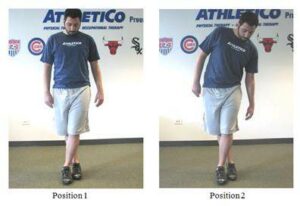 The benefit of the standing ITB stretch is that you can perform it anywhere, whether you’re at home, at work, or in the gym before working out. If it is simpler, you can balance by leaning against a wall. Here’s how to go about it:
The benefit of the standing ITB stretch is that you can perform it anywhere, whether you’re at home, at work, or in the gym before working out. If it is simpler, you can balance by leaning against a wall. Here’s how to go about it:
- Stand straight.
- Cross the hurting (involved) leg and BEHIND the other leg.
- When you feel a stretch across the affected iliotibial band, lean toward the side that is not affected (away from the hurting side).
- Hold for a minute.
- Straighten your legs again and stand up.
- Once more, four times.
Some people experience a stretch where the ITB arises in their hip, but others experience stiffness at their knee during this stretch.
Stretching The Knee To The Opposite Shoulder
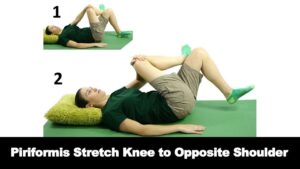 To ITB stretching practice, try this soothing stretch:
To ITB stretching practice, try this soothing stretch:
- Lay down on your back.
- The knee of the affected (painful) leg should be bent.
- Grab both hands behind the knee of the bowed leg and pull it toward the opposing shoulder.
- Hold for a minute.
- Let your leg go.
- Once more, four times.
Cow Face Pose
 This yoga position increases flexibility and mobility by releasing deep stiffness in your thighs, hips, and glutes. Additionally, it extends your ankles and knees.
This yoga position increases flexibility and mobility by releasing deep stiffness in your thighs, hips, and glutes. Additionally, it extends your ankles and knees.
Avert leaning to one side. To ensure that your hips remain balanced, use a cushion to evenly press into the floor both sitting bones. Straighten out your bottom leg to make this pose easier.
- Put your left knee in the middle of your body by bending it.
- Bring your left foot in close to your hip.
- Stacking your knees, cross the right one over the left.
- Your left hip should be on the outside of your right heel and ankle.
- For up to a minute, maintain this posture.
- Walk your hands forward to fold into a forward bend to get deeper.
- Once you have held this position for up to a minute, switch to the other side.
Wall ITB Stretch
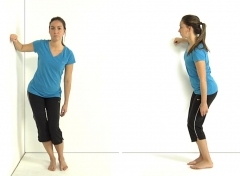 When using the wall for balance, people frequently discover that IT band stretches help them feel more stable and in control.
When using the wall for balance, people frequently discover that IT band stretches help them feel more stable and in control.
- Start off the same way you did for the first exercise, but extend your right leg further to the left. Making sure your hands are over your head can improve the stretch, place your hands on your head or lean against a wall for support.
- Until you feel the IT band stretching, slowly slide your hips to the right while leaning to the left. 30 seconds of holding
- Repeat three times, twice each day, or just before and after exercising.
Abductor Stretch
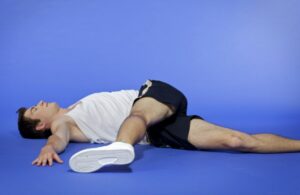 Abductor stretch exercise helps you release tension in your outer thigh muscles, which can help prevent IT band stiffness and pain. To perform this stretch, follow these steps:
Abductor stretch exercise helps you release tension in your outer thigh muscles, which can help prevent IT band stiffness and pain. To perform this stretch, follow these steps:
- Sit on the floor with your legs extended straight out in front of you.
- Lean to the unaffected side so that your upper body is perpendicular to your legs.
- Cross one leg over the other, placing your ankle on the affected knee.
- Bend your affected knee, and slowly lower your chest toward it until you feel a stretch in your outer thigh.
- Hold for 30 seconds and then switch legs.
- Repeat twice per day or before and after working out to prevent IT band pain and stiffness.
Quad Stretch
 Quad stretch is when you stand in a lunge position and then slowly drop your hips down to stretch out the muscles of your thigh. This exercise is especially helpful for stretching the IT band because it helps you target the largest muscle group in that area. To perform this stretch, follow these steps:
Quad stretch is when you stand in a lunge position and then slowly drop your hips down to stretch out the muscles of your thigh. This exercise is especially helpful for stretching the IT band because it helps you target the largest muscle group in that area. To perform this stretch, follow these steps:
- Stand with your feet hip-width apart, and step back with your left foot until you are in a lunge position.
- Lower your hips to the ground and straighten your back leg.
- Hold for 30 seconds, then switch legs. Repeat up to three times per day or before and after exercising.
Knee Flexion Stretch
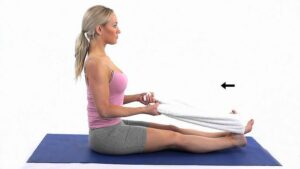 The knee flexion stretch can help release tension in the IT band muscles that are often associated with common running injuries like shin splints. To perform this stretch, follow these steps:
The knee flexion stretch can help release tension in the IT band muscles that are often associated with common running injuries like shin splints. To perform this stretch, follow these steps:
- Lie on your back and straighten out one leg.
- Flex your foot so that your heel is pointing toward the ceiling.
- Keeping your hips level and held still, pull gently on your ankle until you feel a stretch in the front of your thigh.
- Hold for 30 seconds and then switch legs.
- Repeat up to three times per day or before and after exercising.
Belt IT Band Stretch
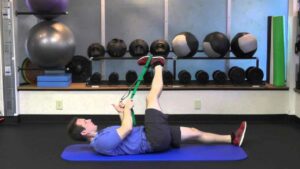 The belt IT band stretch is a good stretch to do after your other stretches to ensure that you fully lengthen your IT band. To perform this stretch, follow these steps:
The belt IT band stretch is a good stretch to do after your other stretches to ensure that you fully lengthen your IT band. To perform this stretch, follow these steps:
- Wrap a small exercise or yoga belt around the affected leg just above the knee.
- Hold one end of the belt in each hand so that your arms are straight and there is tension on the belt.
- Repeat this exercise daily.
Conclusion
These stretches are all great ways to keep your IT band flexible and healthy. Whether you are a runner, yogi, or simply an active person, incorporating regular IT band stretches into your routine can help prevent pain and stiffness in this important part of the body. With consistent practice, you should notice less discomfort and be able to continue doing the activities you love without worry.
You must consult a professional if your pain doesn’t go away or worsens after trying these stretches. If you have any underlying medical conditions, consult with your doctor to make sure that stretching your IT band is the best course of action for you. But overall, we hope that these exercises help you feel more comfortable and pain-free in your body! Good luck!
Physical Therapy help patients recover from pain. If you’re experiencing Back pain, Shoulder pain, Knee pain, Neck pain, Elbow pain, Hip pain, or Arthritis pain, a physical therapist at MantraCare can help: Book a physiotherapy session.


